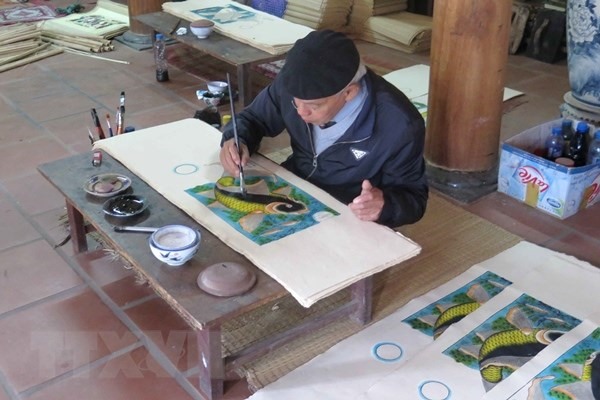[ad_1]
 |
| Artisan Nguyễn Đăng Chế finishes a Đông Hồ painting called Cá Chép Trông Trăng (Moonlight Carp). — VNA/VNS Photo |
HÀ NỘI — Authorities in northern Bắc Ninh Province are planning to compile a dossier on the Vietnamese folk art of Đông Hồ painting in a bid to secure UNESCO recognition.
The proposal of the People’s Committee of Bắc Ninh to compile the dossier to gain UNESCO recognition as an intangible cultural heritage in need of urgent safeguarding has been ratified by the Ministry of Culture, Sports, and Tourism.The provincial Department of Culture, Sports and Tourism has been tasked to collaborate with related organisations to finish the dossier before it is submitted to the provincial People’s Committee for approval.
The effort to secure UNESCO recognition of Đông Hồ painting as an intangible cultural heritage in need of urgent safeguarding is expected to have a significant impact in the preservation and promotion of Vietnamese traditional values as well as in improving communities’ awareness in the protection of such values.
Việt Nam currently has 12 cultural elements inscribed in the UNESCO-recognised list of intangible cultural heritages, including Nhã Nhạc (Vietnamese Royal Music), Space of gong culture, Quan Họ Bắc Ninh folk songs, and ca trù singing, as well as the Gióng Festival, Worship of Hùng Kings, the art of Đờn Ca Tài Tử music and folk songs, and the Ví and Giặm folk songs of Nghệ Tĩnh. Tugging rituals and games, practices related to Vietnamese belief in Mother Goddesses, Xoan singing, and the art of Bài Chòi singing have also been recognised by the UNESCO.
Đông Hồ painting originated in Đông Hồ Village in the Thuận Thành District of the northern province of Bắc Ninh. For centuries, the paintings were used as precious decorations to celebrate the Tết festival. People bought the paintings to hang on their walls for a year, which are then replaced with new ones for the next New Year.
Đông Hồ painting was inscribed in the list of national intangible cultural heritages by the Ministry of Culture, Sports and Tourism in December 2012. — VNS
[ad_2]
Source link
